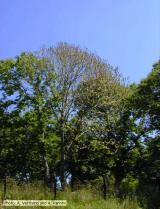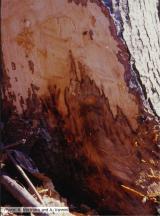Disease
Blepharospora cambivora was recognized by Petri in 1917 as the cause of “Maladie de la encre,” or ink disease of European chestnut (Day 1938, Vannini & Vettraino 2001). It was soon recognized as a Phytophthora species and transferred to that genus by Christina Buisman. Today it is known to be a common pathogen in much of Europe on hardwood forest trees, especially members of the Fagaceae, including chestnut and beech (Belisario & Maccaroni 2006, Cerny et al. 2008, Jung et al. 2005, Nelson et al. 2010, Orlikowski et al. 2006, Schmitz et al. 2007, Vannini & Vettraino 2001, Vettraino et al. 2005). In North America, it is also implicated in root rot of chestnut in the SE United States, but P. cinnamomi proved to be most frequently involved. In 2000 P. cambivora was associated with death of chinquapin (Chrysolepis chrysophylla) forest trees in south central Oregon (Saavedra et al. 2007). It is occasionally isolated from basal cankers on tanoaks (Reeser et al. 2007). P. cambivora is also known as a pathogen of fruit trees.
Phytophthora cambivora, as the cause of ink disease in Europe, may have dramatic economic and ecological consequences in chestnut orchards, high forest, coppices or natural lands, especially in France, Italy and Greece (Vannini & Vettraino 2001, Vettraino et al. 2005). In Germany and nearby countries it is important among the group of Phytophthora species causing bleeding cankers and ultimately mortality on European beech (Belisario & Maccaroni 2006, Jung et al. 2005, Nelson et al. 2010, Orlikowski et al. 2006, Schmitz et al. 2007). It is having a similar impact, although in a much more limited area, on chinquapin in Oregon (Saavedra et al. 2007). P. cambivora causes scattered mortality of other forest trees in Europe (Greslebin et al. 2005, Talgø et al. 2006, Vettraino et al. 2003, Yakabe et al. 2009). P. cambivora has been recovered from forest soils and streams throughout western Oregon, as well as oak forest soils in the eastern United States and Europe, although usually there are no associated symptoms on the trees (Balci et al. 2007, Reeser et al. 2011, Vettraino et al. 2002).
P. cambivora causes root rot and stem cankers on several forest tree species. The symptoms of ink disease of chestnut are typical. Necrosis of feeder or main roots may spread to the collar and the trunk, resulting in the cortical flame shaped lesions with black exudates for which the disease is named (Vannini & Vettraino 2001, Vettraino et al. 2005). Root destruction leads to above ground symptoms, including chlorosis, microphylly, and wilting. These can be followed by a quick or a progressive death depending on the environmental conditions (Vannini & Vettraino 2001, Vettraino et al. 2005). Affected chinquapin trees exhibit girdling basal cankers marked by red-brown inner bark tissues, extending upward from necrotic main roots (Reeser et al. 2007). Cankers on beech in Europe and elsewhere are also marked by bleeding spots but the discoloration of inner bark in active lesions is less dramatic. Bole cankers caused by P. cambivora on tanoak are infrequent, but indistinguishable from those caused by P. ramorum (Reeser et al. 2007).
| Host Latin Name | Host Common Name | Symptoms | Habitat | Region | |
|---|---|---|---|---|---|
| Abies procera | Noble fir | Canker, Root rot | Christmas trees | USA - Oregon | |
| Abies spp. | True firs | Root rot | Christmas trees | Norway, Poland, USA | |
| Acer spp. | Maple | Canker | Forest, Parklands | Europe | |
| Aesculus hippocastanum | Horse chestnut | Root rot | Austria, England | ||
| Alnus glutinosa | European common alder | Canker | Germany, Poland | ||
| Alnus spp. | Alder spp. | Root rot | Forest | USA - Oregon | |
| Castanea crenata | Japanese chestnut | Root rot | Japan | ||
| Castanea dentata | American chestnut | Root rot | USA | ||
| Castanea sativa | Chestnut, Sweet chestnut | Canker, Root rot | Forest, Plantations | Czech Republic, England, France, Greece, Hungary, Italy, Portugal, Romania, Slovakia, Spain, Switzerland, Turkey | |
| Chrysolepis chrysophylla | Chinquapin | Canker | Forest | USA - Oregon | |
| Chrysolepis chrysophylla | Chinquapin | Canker | Forest | USA - Pacific Northwest | |
| Fagus sylvatica | Beech | Root rot | Forest, Parklands | Austria, Belgium, Czech Republic, Germany, Greece, Italy, Poland, Romania | |
| Juglans spp. | Walnut | Canker, Root rot | Plantations | Europe, USA | |
| Notholithocarpus densiflorus | Tanoak | Canker | Forest | USA - Pacific Northwest | |
| Platanus orientalis | Sycamore | Canker | Forest, Parklands | Europe | |
| Quercus spp. | Deciduous oaks, Oak | Root rot | Forest | Czech Republic, France, Germany, Italy, United Kingdom, USA |




